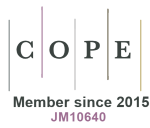Pharmacokinetics of the disialoganglioside, GD2, a circulating tumor biomarker for neuroblastoma, in nonhuman primates
DOI:
https://doi.org/10.33393/jcb.2021.2329Keywords:
biomarker, ganglioside, Neuroblastoma, PharmacokineticsAbstract
Background: The ganglioside GD2 is a potential circulating tumor biomarker for the childhood cancer, neuroblastoma. Interpreting the levels of a circulating tumor biomarker depends in part on a knowledge of the biomarker’s clinical pharmacology.
Background: The ganglioside GD2 is a potential circulating tumor biomarker for the childhood cancer neuroblastoma. Interpreting the levels of a circulating tumor biomarker depends in part on a knowledge of the biomarker’s clinical pharmacology.
Methods: We studied the plasma and cerebrospinal fluid (CSF) pharmacokinetics of the C18 lipoform of GD2 in two nonhuman primates with indwelling subcutaneous CSF lateral ventricular reservoir systems. GD2 was quantified with a validated high-performance liquid chromatography (HPLC)/tandem mass spectrometry assay. GD2 was administered as a short intravenous infusion and frequent plasma and CSF samples were drawn over 72 hours.
Results: GD2 plasma concentration declined monoexponentially with a half-life of 16 hours. Clearance was 0.0136 and 0.0131 L/h and volume of distribution (Vd) was 0.035 and 0.038 L/kg in the two animals. Vd was equivalent to plasma volume. Greater than 98% of GD2 in plasma is in a bound form consistent with its known association with lipoproteins and accounting for its limited volume of distribution. GD2 did not cross over from plasma into the CSF.
Conclusions: The pharmacokinetic profile of GD2 is favorable for a circulating tumor biomarker. This study demonstrates the value of characterizing the clinical pharmacology of circulating biomarkers to better understand their clinical behavior.
References
- Balis FM, Busch CM, Desai AV, et al. The ganglioside GD2 as a circulating tumor biomarker for neuroblastoma. Pediatr Blood Cancer. 2020;67(1):e28031. https://doi.org/10.1002/pbc.28031PMID:31612589 DOI: https://doi.org/10.1002/pbc.28031
- Lester McCully CM, Bacher J, MacAllister RP, et al. Development of a cerebrospinal fluid lateral reservoir model in rhesus monkeys (Macaca mulatta). Comp Med. 2015;65(1):77-82. PMID:25730761
- Guide for care and use of laboratory animals. 8th ed. Washington, DC: The National Academies Press 2011. http://grants.nih.gov/grants/olaw/guide-for-the-care-and-use-of-laboratory-animals.pdf
- Busch CM, Desai AV, Moorthy GS, Fox E, Balis FM. A validated HPLC-MS/MS method for estimating the concentration of the ganglioside, GD2, in human plasma or serum. J Chromatogr B Analyt Technol Biomed Life Sci. 2018;1102-1103:60-65. https://doi.org/10.1016/j.jchromb.2018.10.010 PMID:30368044 DOI: https://doi.org/10.1016/j.jchromb.2018.10.010
- Hobbs TR, Blue SW, Park BS, Greisel JJ, Conn PM, Pau FK. Measurement of blood volume in adult rhesus macaques (Macaca mulatta). J Am Assoc Lab Anim Sci. 2015;54(6):687-693. PMID:26632777
- Ladisch S, Wu ZL, Feig S, et al. Shedding of GD2 ganglioside by human neuroblastoma. Int J Cancer. 1987;39(1):73-76. https://doi.org/10.1002/ijc.2910390113 PMID:3539825 DOI: https://doi.org/10.1002/ijc.2910390113
- Baratz E, McCully C, Shih J, Warren K. Comparison of pharmacokinetic parameters between non-human primates and human patients. Neuro-oncol. 2018;20(suppl 2):i157. https://doi.org/10.1093/neuonc/noy059.582 DOI: https://doi.org/10.1093/neuonc/noy059.582
- Valentino LA, Ladisch S. Localization of shed human tumor gangliosides: association with serum lipoproteins. Cancer Res. 1992;52(4):810-814. PMID:1737341










